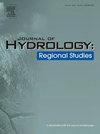Spatiotemporal desynchronization in the propagation from meteorological to soil moisture drought in the Loess Plateau, China
IF 4.7
2区 地球科学
Q1 WATER RESOURCES
引用次数: 0
Abstract
Study Region
The Loess Plateau (LP) of China
Study Focus
Meteorological drought (MD) would propagate to soil moisture drought (SMD) with spatiotemporal desynchronization. The spatial desynchronization between them has frequently been ignored in previous studies due to limitation of identified droughts, which did not consider their 3-dimensional (3D, i.e. longitude, latitude and time) properties. This study presents a 3D perspective on the spatiotemporal desynchronization in the propagation from meteorological to soil moisture drought in the the Loess Plateau (LP) of China, using an improved drought matching method. Event Synchronization (ES) is extended to determine temporal linkage of the two types of droughts and spatial connection is tested using overlapping area.
New Hydrological Insights for the Region
The results showed that: (1) the improved method is reasonable for identifying MDs that trigger SMDs, down to specific clusters; (2) 8 SMDs preceded MDs 1 month, while approximately 79 % of SMDs did not recover after the determination of MDs; (3) severity of MD is an impact factor on recovery lag, while antecedent soil moisture dominates onset lag with the relative importance of approximately 50 %; and (4) incompletely overlap in migration trajectory between the two types of droughts was mainly caused by temperature, followed by antecedent soil moisture and potential evapotranspiration, with relative importance of 55 %, 14 % and 12 %, respectively.
中国黄土高原从气象干旱到土壤水分干旱传播过程中的时空不同步现象
研究区域中国黄土高原(LP)研究重点气象干旱(MD)会随着时空不同步传播到土壤水分干旱(SMD)。在以往的研究中,由于识别干旱的局限性,没有考虑它们的三维(3D,即经度、纬度和时间)特性,它们之间的空间非同步性经常被忽视。本研究采用改进的干旱匹配方法,从三维角度探讨了中国黄土高原(LP)从气象干旱到土壤水分干旱传播过程中的时空非同步性。结果表明:(1) 改进的方法是合理的;(2) 改进的方法是有效的;(3) 改进的方法是可行的;(4) 改进的方法是可行的;(5) 改进的方法是可行的:结果表明:(1) 改进后的方法可以合理地识别出引发 SMD 的多级干旱,甚至是特定的群集;(2) 8 个 SMD 比多级干旱早发生 1 个月,而约 79% 的 SMD 在确定多级干旱后没有恢复;(3) 多级干旱的严重程度是恢复滞后的影响因素,而先期土壤水分主导了起始滞后,相对重要性约为 50%;(4) 两种干旱的迁移轨迹不完全重合主要是由温度造成的,其次是先决土壤水分和潜在蒸散量,相对重要性分别为 55%、14% 和 12%。
本文章由计算机程序翻译,如有差异,请以英文原文为准。
求助全文
约1分钟内获得全文
求助全文
来源期刊

Journal of Hydrology-Regional Studies
Earth and Planetary Sciences-Earth and Planetary Sciences (miscellaneous)
CiteScore
6.70
自引率
8.50%
发文量
284
审稿时长
60 days
期刊介绍:
Journal of Hydrology: Regional Studies publishes original research papers enhancing the science of hydrology and aiming at region-specific problems, past and future conditions, analysis, review and solutions. The journal particularly welcomes research papers that deliver new insights into region-specific hydrological processes and responses to changing conditions, as well as contributions that incorporate interdisciplinarity and translational science.
 求助内容:
求助内容: 应助结果提醒方式:
应助结果提醒方式:


